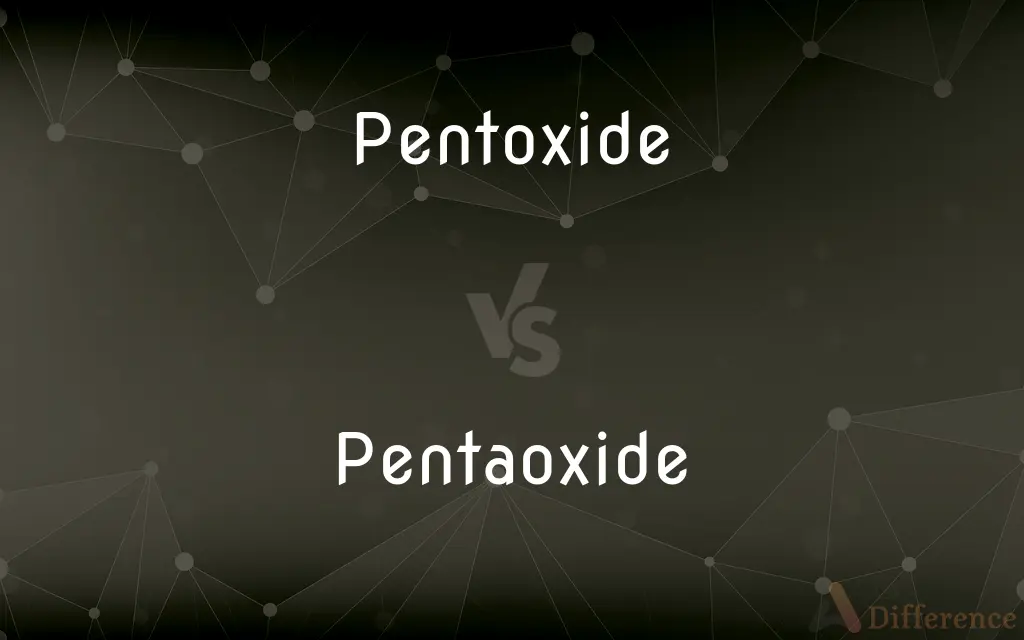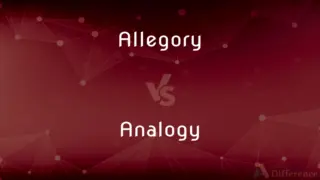Pentoxide vs. Pentaoxide — What's the Difference?
By Fiza Rafique & Urooj Arif — Updated on April 15, 2024
Pentoxide and pentaoxide refer to the same chemical compound composition, typically represented as containing five oxygen atoms; the term "pentoxide" is more commonly used in scientific nomenclature.

Difference Between Pentoxide and Pentaoxide
Table of Contents
ADVERTISEMENT
Key Differences
Pentoxide is a term used in chemistry to describe a compound that contains five oxygen atoms bonded to another element. This term is commonly used in scientific contexts to ensure clarity and precision in chemical formulas. On the other hand, pentaoxide, while also referring to a chemical compound with five oxygen atoms, is less frequently used in formal chemical nomenclature. The use of "pentaoxide" may occur in less formal contexts or in varying scientific literature, but it does not conform to the IUPAC (International Union of Pure and Applied Chemistry) recommendations, which prefer the use of "pentoxide" for consistency.
Both terms, pentoxide and pentaoxide, are understood among chemists to imply a specific stoichiometry in a compound, where the ratio of oxygen atoms to another central atom is 5:1. These compounds are often important in various chemical reactions, particularly those involving oxidization processes.
While pentoxide is the preferred term, pentaoxide might still appear in educational materials or less standardized texts. It is important for students and professionals in chemistry to recognize that these terms refer to the same types of compounds, ensuring proper understanding regardless of the terminology used.
The consistency in using "pentoxide" across scientific papers, textbooks, and chemical databases helps maintain a uniform language in chemistry, which facilitates clearer communication and documentation of chemical substances. Whereas "pentaoxide" serves as a reminder of the variability in chemical nomenclature that can exist across different regions or periods.
Comparison Chart
Usage in IUPAC Nomenclature
Preferred
Less preferred
ADVERTISEMENT
Frequency of Use
Common in scientific texts
Less common
Example Compound
Phosphorus pentoxide (P2O5)
Same as pentoxide
Context of Use
Formal, academic and professional
Informal or varied contexts
Implication
Strict chemical stoichiometry (5:1 oxygen to other atoms)
Same stoichiometry as pentoxide
Compare with Definitions
Pentoxide
Often used in descriptions of oxidizing agents.
Vanadium pentoxide catalyzes the oxidation of sulfur dioxide in industrial processes.
Pentaoxide
Implies the same chemical properties as pentoxide.
Dinitrogen pentaoxide shares properties with dinitrogen pentoxide.
Pentoxide
A chemical term aligning with IUPAC standards.
Phosphorus pentoxide is a desiccant.
Pentaoxide
Occasionally used in academic texts.
Antimony pentaoxide is discussed in older chemical literature.
Pentoxide
A compound with five oxygen atoms.
Sulfur pentoxide is used in the manufacture of sulfuric acid.
Pentaoxide
Might appear in regional chemical nomenclature.
Niobium pentaoxide can also be referred to as niobium pentaoxide.
Pentoxide
Appears in scientific and industrial contexts.
Dinitrogen pentoxide is employed as an nitrating agent.
Pentaoxide
Less formal term for a five-oxygen compound.
In some textbooks, vanadium pentaoxide is mentioned.
Pentoxide
Denotes a specific oxidation state of an element.
Niobium pentoxide is used in the production of special glass.
Pentaoxide
Used less frequently in professional settings.
Chromium pentaoxide is a term sometimes encountered in translations.
Pentoxide
Pentoxide may refer to:
Pentoxide
An oxide containing five atoms of oxygen in its molecule or empirical formula.
Pentoxide
A compound having five atoms of oxygen combined with another element.
Pentoxide
(inorganic chemistry) any oxide containing five oxygen atoms in each molecule
Pentoxide
An oxide containing five atoms of oxygen in each molecule; as, phosphorus pentoxide, P2O5.
Pentoxide
An oxide containing five atoms of oxygen in the molecule
Common Curiosities
Are pentoxide and pentaoxide the same?
Yes, both terms refer to compounds containing five oxygen atoms; however, "pentoxide" is more commonly accepted.
Is pentaoxide recognized in all scientific communities?
While understood, it's less formally recognized compared to "pentoxide".
What are some examples of pentoxide compounds?
Examples include phosphorus pentoxide, sulfur pentoxide, and vanadium pentoxide.
Where might I encounter the term pentaoxide?
In less formal educational resources or older scientific literature.
Why is pentoxide more commonly used than pentaoxide?
"Pentoxide" aligns with IUPAC nomenclature, making it more standard in scientific communication.
Can I use pentaoxide in a scientific paper?
It is recommended to use "pentoxide" to adhere to standardized chemical nomenclature.
How do pentoxide compounds interact in chemical reactions?
They often act as oxidizing agents or react with water to form acids or other compounds.
What is pentoxide used for?
Pentoxide compounds are used in various applications like desiccants, catalysts, and in the manufacture of acids.
What is the significance of the oxygen ratio in pentoxides?
The 5:1 oxygen ratio is crucial in determining the chemical and physical properties of the compounds.
What educational level should start using the term pentoxide?
As soon as chemical nomenclature is introduced, typically in high school chemistry.
How are new users of chemistry taught about these terms?
Through textbooks and educational materials that emphasize IUPAC nomenclature and its importance in scientific communication.
How does the use of pentoxide enhance scientific communication?
It ensures clarity and uniformity across chemical literature and databases.
What should I do if I find pentaoxide in a textbook?
Understand it refers to the same type of compound as pentoxide and check the context for clarity.
Are there any industrial uses for pentoxide compounds?
Yes, they are used in processes like the production of glass, ceramics, and chemical intermediates.
Is it incorrect to use pentaoxide in academic work?
It's not incorrect, but using "pentoxide" is more advisable for consistency and standardization.
Share Your Discovery

Previous Comparison
Edjamacation vs. Education
Next Comparison
Allegory vs. AnalogyAuthor Spotlight
Written by
Fiza RafiqueFiza Rafique is a skilled content writer at AskDifference.com, where she meticulously refines and enhances written pieces. Drawing from her vast editorial expertise, Fiza ensures clarity, accuracy, and precision in every article. Passionate about language, she continually seeks to elevate the quality of content for readers worldwide.
Co-written by
Urooj ArifUrooj is a skilled content writer at Ask Difference, known for her exceptional ability to simplify complex topics into engaging and informative content. With a passion for research and a flair for clear, concise writing, she consistently delivers articles that resonate with our diverse audience.














































